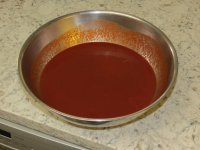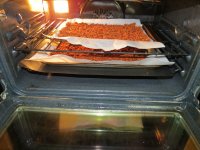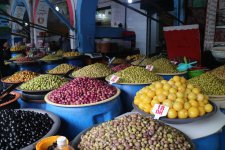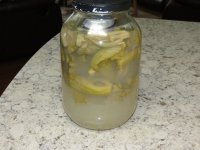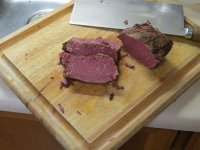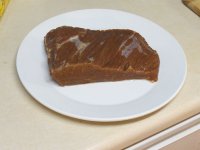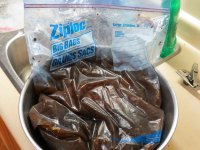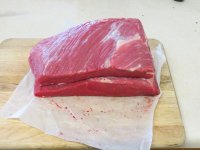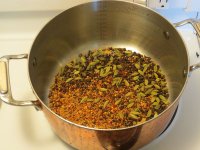Here's the finished fermented flake sauce. Looks to be about 1.5 litres.
Similar in texture to Louisiana style but hotter and not as tangy as there's no vinegar. The salts are a combo of coarse, Himalayan and Black Lava. After it was heated, I added some iodized salt to help prevent further fermenting.
Similar in texture to Louisiana style but hotter and not as tangy as there's no vinegar. The salts are a combo of coarse, Himalayan and Black Lava. After it was heated, I added some iodized salt to help prevent further fermenting.
Attachments
That looks delicious! Will try that with some local red chiles I have. Thanks for posting that Cal
Phil

Phil
Many times the tajines contained pickled lemon; lemon pickled with salt (salt and sour). The taste of the sour lemon in a veggy tajine was SO GOOD.
On this market in Fes or Meknes, cannot remember, olives of all kinds were sold together with oil and pickled stuff (lemons seen in the front). 18Dh (Dirham) is approx USD2 and I think that was for a kilogram!!!
I just had to find recipes for the lemons:
Recipe #1
Recipe #2
Recipe #3
On this market in Fes or Meknes, cannot remember, olives of all kinds were sold together with oil and pickled stuff (lemons seen in the front). 18Dh (Dirham) is approx USD2 and I think that was for a kilogram!!!
I just had to find recipes for the lemons:
Recipe #1
Recipe #2
Recipe #3
Attachments
Grade "D" -- edible
Some famous chefs discuss corned beef in NYTimes food section ...Seamus Mullen discusses the beef used in his high school cafeteria:
https://www.nytimes.com/2017/03/06/dining/corned-beef-recipe.html
Some famous chefs discuss corned beef in NYTimes food section ...Seamus Mullen discusses the beef used in his high school cafeteria:
https://www.nytimes.com/2017/03/06/dining/corned-beef-recipe.html
A little time and patience and corned beef heaven can be at your doorstep.corned beef
Attachments
Hi Cal, this corned beef woke me up 😀
What are ingredients of your corned beef seed collection?
I see green cardamom, mustard seed, black pepper, coriander seed, piment pepper, some chillie flakes and cloves. What do i miss? Which liquid do you use? How long in marinade? How long and which temperature you cook?
Thanks
Frank
What are ingredients of your corned beef seed collection?
I see green cardamom, mustard seed, black pepper, coriander seed, piment pepper, some chillie flakes and cloves. What do i miss? Which liquid do you use? How long in marinade? How long and which temperature you cook?
Thanks
Frank
Thank you very much Cal, i did not see that before, so maybe its time get a white stick and a dog. 😉
Frank, click on the attachment under the pictures. Gives the whole story.
A question do folks really care about their smoked/cured meat to have a pink color? I never use curing salt or straight MSG for that matter in any recipe. I noticed Steve Raichlen on PBS is really big on it for the appearance, does it do anything else? Steve is an old friend from the wine/foodie days in Cambridge MA.
Curing salt #1 (6.25% sodium nitrite) are used to help prevent spoilage of meat that is smoke cured. It does effect flavor as well as color, causing the pink finish in cured meat. This is for meat that will not be stored for long periods of time.
Curing salt #2 (6.25% Sodium Nitrite plus 4% Sodium Nitrate) is used for dry cure meat which is not cooked (smoked) and is for meat with longer storage time.
The salts do effect flavor.
Curing salt #2 (6.25% Sodium Nitrite plus 4% Sodium Nitrate) is used for dry cure meat which is not cooked (smoked) and is for meat with longer storage time.
The salts do effect flavor.
Curing salt #1 (6.25% sodium nitrite) are used to help prevent spoilage of meat that is smoke cured. It does effect flavor as well as color, causing the pink finish in cured meat. This is for meat that will not be stored for long periods of time.
Curing salt #2 (6.25% Sodium Nitrite plus 4% Sodium Nitrate) is used for dry cure meat which is not cooked (smoked) and is for meat with longer storage time.
The salts do effect flavor.
This does not excite my interest. Steve's presentations are always for nearly immediate consumption. BTW due to some family circumstances I might be near some lakes with crappie/bass fishing for weeks at a time, someone caught a seriously big crappie last year.
I would not think of using it that way. I use it only for preserving. The colouration of the meat is a secondary bonus.nearly immediate consumption.
Here's the finished fermented flake sauce. Looks to be about 1.5 litres.
Similar in texture to Louisiana style but hotter and not as tangy as there's no vinegar. The salts are a combo of coarse, Himalayan and Black Lava. After it was heated, I added some iodized salt to help prevent further fermenting.
Any chance of botulism if there is no vinegar?
Any chance of botulism if there is no vinegar?
He would need to make/store it anaerobically. In one of my more extreme foodie moments I bought a medical text book describing every case of food poisoning resulting in a fatality for several decades in the US. Dilly beans with insufficient acid were among the culprits but they were canned and sealed before use. The most obscure was fava bean allergy, which in extreme cases can kill.
Last edited:
Before vinegar, there were yeast and good molds. I believe if it is controlled, then all those years of experience have made the practice safe. You have to use a good amount of salt, so I'm sure that plays a role.
- Home
- Member Areas
- The Lounge
- The food thread
